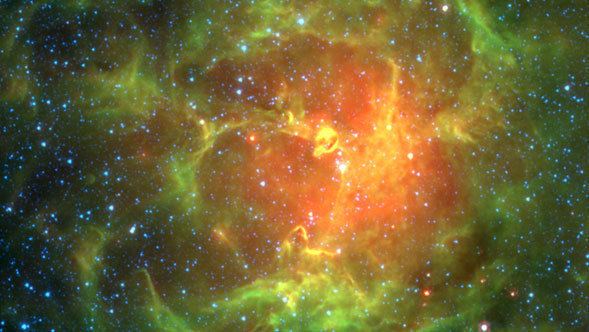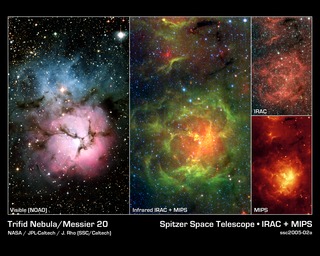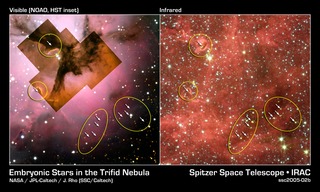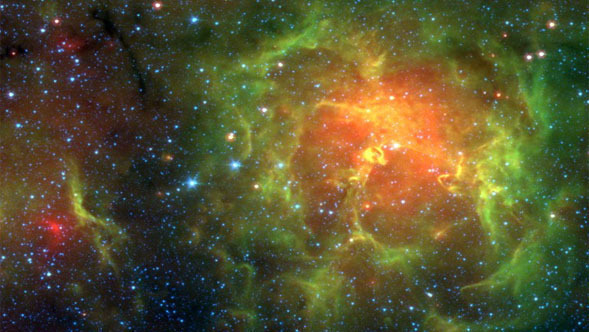
News Release • January 12th, 2005 • ssc2005-02 •
NASA's Spitzer Space Telescope has uncovered a hatchery for massive stars.
A new striking image from the infrared telescope shows a vibrant cloud called the Trifid Nebula dotted with glowing stellar "incubators." Tucked deep inside these incubators are rapidly growing embryonic stars, whose warmth Spitzer was able to see for the first time with its powerful heat-seeking eyes.
The new view offers a rare glimpse at the earliest stages of massive star formation -- a time when developing stars are about to burst into existence.
"Massive stars develop in very dark regions so quickly that is hard to catch them forming," said Dr. Jeonghee Rho of the Spitzer Science Center, California Institute of Technology, Pasadena, Calif., principal investigator of the recent observations. "With Spitzer, it's like having an ultrasound for stars. We can see into dust cocoons and visualize how many embryos are in each of them."
The new false-color image can be found at /Media. It was presented today at the 205th meeting of the American Astronomical Society in San Diego, Calif.
The Trifid Nebula is a giant star-forming cloud of gas and dust located 5,400 light-years away in the constellation Sagittarius. Previous images taken by the Institute for Radioastronomy millimeter telescope in Spain show that the nebula contains four cold knots, or cores, of dust. Such cores are "incubators" where stars are born. Astronomers thought the ones in the Trifid Nebula were not yet ripe for stars. But, when Spitzer set its infrared eyes on all four cores, it found that they had already begun to develop warm stellar embryos.
"Spitzer can see the material from the dark cores falling onto the surfaces of the embryonic stars, because the material gets hotter as gravity draws it in," said Dr. William T. Reach of the Spitzer Science Center, co-author of this new research. "By measuring the infrared brightness, we can not only see the individual embryos but determine their growth rate."
The Trifid Nebula is unique in that it is dominated by one massive central star, 300,000 years old. Radiation and winds emanating from the star have sculpted the Trifid cloud into its current cavernous shape. These winds have also acted like shock waves to compress gas and dust into dark cores, whose gravity caused more material to fall inward until embryonic stars were formed. In time, the growing embryos will accumulate enough mass to ignite and explode out of their cores like baby birds busting out of their eggs.
Because the Trifid Nebula is home to just one massive star, it provides astronomers a rare chance to study an isolated family unit. All of the newfound stellar embryos are descended from the nebula's main star. Said Rho, "Looking at the image, you know exactly where the embryos came from. We use their colors to determine how old they are. It's like studying the family tree for a generation of stars."
Spitzer discovered 30 embryonic stars in the Trifid Nebula's four cores and dark clouds. Multiple embryos were found inside two massive cores, while a sole embryo was seen in each of the other two. This is one of the first times that clusters of embryos have been observed in single cores at this early stage of stellar development.
"In the cores with multiple embryos, we are seeing that the most massive and brightest of the bunch is near the center. This implies that the developing stars are competing for materials, and that the embryo with the most material will grow to be the largest star," said Dr. Bertrand Lefloch of Observatoire de Grenoble, France, co-author of the new research.
Spitzer also uncovered about 120 small baby stars buried inside the outer clouds of the nebula. These newborns were probably formed around the same time as the main massive star and are its smaller siblings.
Other authors of this work include Dr. Giovanni Fazio, Smithsonian Astrophysical Observatory, Cambridge, Mass.
NASA's Jet Propulsion Laboratory, Pasadena, Calif., manages the Spitzer Space Telescope mission for NASA's Science Mission Directorate, Washington, D.C. Science operations are conducted at the Spitzer Science Center, Pasadena, Calif. JPL is a division of Caltech.
The new Spitzer image is a combination of data from the telescope's infrared array camera and multiband imaging photometer. The infrared array camera was built by NASA Goddard Space Flight Center, Greenbelt, Md.; its development was led by Fazio. The multiband imaging photometer was built by Ball Aerospace Corporation, Boulder, Colo., the University of Arizona, Tucson, and Boeing North American, Canoga Park, Calif. The instrument's development was led by Dr.George Rieke, University of Arizona.
News Media Contact
Whitney Clavin (626) 395-1877
Jet Propulsion Laboratory, Pasadena, Calif.
Gay Hill
(818) 354-0344
Jet Propulsion Laboratory, Pasadena, Calif.







